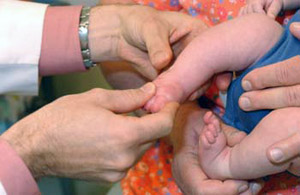Children can be sensitive to any physical difference they have from other children. But the patients that Christina Gurnett, M.D., Ph.D. studies are not just worried about having big ears, eyeglasses or braces. Her patients have more emotionally devastating musculoskeletal disorders, including hands with more or less than five fingers, clubfoot and scoliosis.

Since the cause of these disorders and others like them is unknown, Gurnett, an assistant professor of neurology and pediatrics, is examining the possible genetic causes of these common disorders, which run in families.
“As a neurologist, I want to take a new look at birth defects and the different genetic pathways that might be involved,” Gurnett said. “Once we understand the underlying cause, we can work to find treatments for them.”
To do so, Gurnett is evaluating the hundreds of children treated in St. Louis Children’s Hospital’s orthopedic clinic who have a congenital birth defect to search for a cause of their disorder.
“The orthopedic center sees 175 new patients a year with clubfoot, one of the most common birth defects, which affects one in 1,000 children,” Gurnett said. “Twenty percent of those children have a family history of the disorder. We want to find markers or genes that will help develop an animal model so we can better understand what goes awry to cause these birth defects and ultimately figure out how to better treat and prevent them.”
One large family Gurnett is working with has a history of split hand malformation, a congenital limb malformation characterized by a deep cleft of the hand. Gurnett and her colleagues set up a genetics pedigree chart that shows which family members had the cleft hand.
“The third-generation women in this family are fearful of having children,” Gurnett said. “We want to find the gene to help them determine their children’s odds of having the disorder so we can find a way to prevent it. We may not find it the next day or the next week, but maybe in five to 10 years we will be able to use our advances in the lab to help patients in the clinic.”
Another large family Gurnett is studying has 13 females with scoliosis. She and her colleagues examined each family member and collected DNA samples from 15 affected and 36 unaffected family members, and plan to look for markers on chromosomes common to each of the women with scoliosis, then sequence the genes.
Gurnett is collaborating with Matthew Dobbs, M.D., associate professor of orthopaedic surgery. Together, they have established a DNA databank of musculoskeletal disorders that includes more than 700 DNA samples of patients with clubfoot; scoliosis; kyphosis, a curving of the spine that causes a bowing of the back, which leads to a hunchback or slouching posture; congenital vertical talus, a common cause of rigid flat foot; triphalangeal thumb, where the hand has another finger in place of a thumb; polydactyly, which causes the hands to have more than five fingers; and patients with other limb abnormalities.
Her research on limb development encompasses areas of critical importance in children’s health, as these disorders severely impact quality of life and the mobility of children worldwide. Her work will provide a critical bridge between the rapid gains in genetic technology and the clinical need to answer biologically relevant questions in children with musculoskeletal disease.